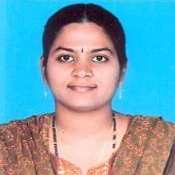
Megha P Arakeri
Work place: M.S Ramaiah Institute of Technology, M.S.R Nagar, Bangalore 560-054, India
E-mail:
Website:
Research Interests: Medical Image Computing, Image Processing, Pattern Recognition, Computer Vision
Biography
Dr. Megha. P. Arakeri, (born November 10, 1979) obtained her Master’s degree in computer science from Jawaharlal Nehru National College of Engineering, Shimoga, India. She obtained Ph.D in Information Technology from National Institute of Technology Karnataka (NITK), Surathkal, India. She is currently working as Associate Professor in the department of Information Science and Engineering in M. S. Ramaiah Institute of Technology. Her research interests include Medical Image Processing, Computer Vision, Information Retrieval, and Pattern Recognition
Author Articles
Analysis of Late Blight Disease in Tomato Leaf Using Image Processing Techniques
By Megha P Arakeri Malavika Arun Padmini R K
DOI: https://doi.org/10.5815/ijem.2015.04.02, Pub. Date: 8 Nov. 2015
Tomato (Lycopersicon esculentum L.) is one of the most widely grown crops in the world. This crop is easily prone to various diseases. One such disease is late blight, caused by the fungus Phytophthora infestans. The first symptoms of late blight on tomato leaves are irregularly shaped, water soaked lesions, which are typically found on the younger leaves of the plant canopy. During humid conditions, white cottony growth may be visible on the underside of affected leaves. As the disease progresses, lesions enlarge causing leaves to brown, shrivel and perish. Hence in the present paper, a novel computer vision system has been proposed for detection and analysis of late blight disease. The proposed system implements thresholding algorithm to classify the leaf as diseased or healthy. Later it uses K -means clustering algorithm for analyzing late blight disease. The experiment was carried out on leaves of tomato collected from various plantations. The accuracy, sensitivity and specificity of the developed system in analyzing the late blight disease are 84%, 85% and 80% respectively.
[...] Read more.Other Articles
Subscribe to receive issue release notifications and newsletters from MECS Press journals